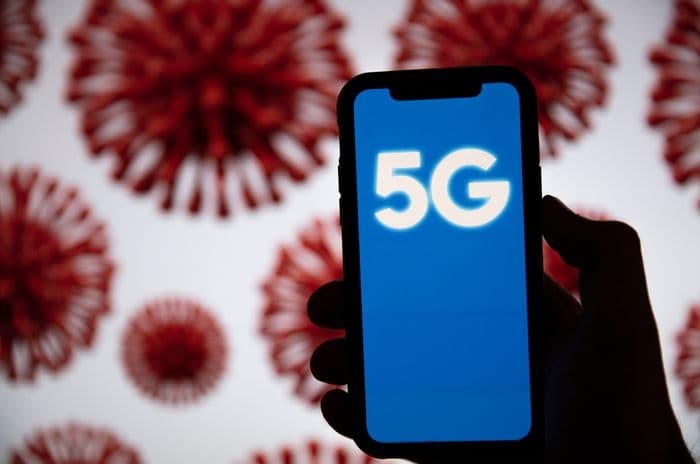5G operates on the part of the radio spectrum emitting non-ionising radiation meaning it is not harmful to humans.
Nor has 5G ever been credibly linked to health issues like cancer or coronavirus.
Plus, 5G masts have been tested to check whether they are safe. All masts and antennae must meet international guidelines for safety.

Is 5G safe?
5G is the latest generation of mobile technology. It follows on from 4G and promises to deliver faster mobile speeds to customers across the world.
However, since 5G was first switched on in the UK, questions have been asked about how safe it is.
There's plenty of confusion about 5G and what is actually does, so let's look more closely at how safe 5G is to mobile users and the public more generally.
5G and radiation
5G uses radio frequencies to deliver services to customers and all the frequencies used by 5G and other mobile services like 4G fall within the non-ionising radiation part of the electromagnetic spectrum.
There's a major difference between non-ionising radiation and ionising radiation:
- Non-ionising radiation is not harmful to humans while ionising radiation can be hazardous.
Non-ionising radiation comes from low-energy radio waves like those found in common household items whereas ionising radiation is the more dangerous type found in x-rays and gamma rays.
Radio frequencies that are non-ionising don't carry enough energy to damage cells in the human body unlike the amount of energy found in ionising radiation sources such as nuclear waste processing or an x-ray of a broken leg.
Incidentally, this doesn't mean that anyone who has ever had a dental x-ray is in danger from ionising radiation. We all have occasional exposure to background radiation in modern life, but it's only truly damaging when we're regularly exposed through work, for example.
There's no link between non-ionising radiation and harm to the human body.
5G spectrum
The spectrum used for 5G services in the UK has previously been used for other things such as wireless broadband and TV broadcasting. In this sense, these radio frequencies have been around for many years. Some of it continues to be partly used for other purposes.
Ofcom have auctioned off parts of the spectrum used for:
- Ministry of Defence communications (2.3GHz to 3.4GHz)
- 4G wireless broadband (3.4GHz)
- Fixing links and satellite services (3.6GHz to 3.8GHz)
- Freeview TV and wireless microphones (700MHz)
They're also working to free up other usable spectrum and there will likely be more auctions in the future to provide more options for networks.
Higher frequency 5G bands known as millimetre wave (mmWave) aren't used by networks in the UK yet, although some trials have already taken place.
These frequencies can be used to deliver very high speeds with minimal latency (delay), but signals don't travel as far and are easily impeded by obstacles such as walls. When they are introduced, we're more likely to see them used in areas of high demand to boost short-range signals.
Frequencies such as 26GHz, 40 GHz and 66GHz are still safe and have also been used for other services over the years. There are additional restrictions for using spectrum at these higher frequencies
5G and cancer
5G does not have any known links to cancer.
One of the major worries about all types of radiation is the potential for it to be a carcinogen or something that causes cancer.
As we've already explained above, non-ionising radiation isn't hazardous to humans in that way and so the possibility of 5G causing cancer is a myth rather than anything rooted in fact.
The World Health Organization (WHO) has been monitoring the effects of exposure to electromagnetic fields (EMF) since 1996 when they set up the International EMF Project to assess if there were any adverse effects on health.
Something often cited by 5G critics is the fact that the International Agency for Research on Cancer (IARC) has classified radiofrequency electromagnetic fields as possibly carcinogenic.
The reason it's put into this category (also known as Group 2B) is because an association could be credible but it can't comprehensively be ruled out either. For reference, Group 2B also includes things like pickled vegetables and aloe vera.
Radiofrequency electromagnetic fields are not in the higher Group 2A which contains things that are probably carcinogenic.
Another set of guidelines from the International Commission on Non-Ionizing Radiation Protection (ICNIRP) has been updated to include 5G and remains virtually unchanged since the guidance was first issued in 1998.
The ICNIRP confirmed in March 2020 that 5G does not have adverse effects on human health.
5G and coronavirus
5G has absolutely no link to the Covid-19 outbreak that hit the UK in 2020.
Widely shared theories suggested a link between the two and resulted in attacks on 159 base stations between 1 February 2020 and 31 July 2020. Engineers were also threatened in the street.
There is no scientific evidence or a credible basis for any connection between 5G and Covid-19.
Are 5G masts safe?
5G masts need to be installed to make sure customers can use the UK's 5G network, but there is no danger from these masks being installed near to homes, businesses or schools.
Ofcom regularly carries out monitoring tests on 5G masts to check what signals are being given out and whether those could be harmful by following the guidelines set out by the ICNIRP.
February 2020 tests looked at radio wave emission levels in 10 towns and cities across the UK where 5G sites are active. They found:
- The maximum measurement was 1.5% of the guideline levels and this included signals from other technologies like 4G
- The highest level recorded from 5G signals specifically only reached 0.039% of the maximum permitted amount
So, the signal measurements for 5G are well within ICNIRP guidelines and 5G signals would need to increase by at least 200 times to breach the guidance.
There is no scientific basis to the idea that 5G masts are harmful and research based on information from The National Register of RF Workers suggests around 4,5000 people are working close to radio frequency radiation in the UK and they receive around five times the exposure a normal person receives. They have not shown higher rates of illness or health difficulties.
Antenna technology
Targeted antennae technology that directs signals to where they need to go is more efficient and also completely safe.
Multiple input, multiple output (MIMO) and beamforming antennae are already used in 4G technology and will be used more regularly in 5G.
The same rules apply for these antennae, so they must be tested by networks and cannot exceed the acceptable measurements in the ICNIRP.
Small cells
Another concern put forward about 5G masts is whether there will be any increased risk of harm if more smaller transmitters or small cells are used.
These could be used in busy locations to improve 5G capacity, so busy city streets and public areas could see extra small cells dotted around.
Yet even though there might be more of them, the small cells operate at much lower strengths than full masts so they will be unlikely to cause an increase to the amount of radio frequency exposure around.
Rollouts of 5G
5G has been active in the UK since 2019, with EE becoming the first network to switch on 5G sites back in May 2019.
Vodafone, O2 and Three have also been rolling out their 5G networks over the last two years, but progress still remains slow and it isn't unusual for coverage to be very patchy.
Even when Three make pronouncements about reaching 300 locations with 5G as they did in August 2021, that only equated to 29% of the UK's population (that's where the people are rather than the whole of the UK landmass).
EE's goal is to reach 90% of the UK's landmass with 5G services by 2028 and they will retire old 3G spectrum to re-use for 5G services as part of their strategy.
What this means is that we're likely to hear plenty more of unwarranted criticisms about the safety of 5G in the years ahead as more 5G masts spring up and the technology becomes more widespread.
We've already seen the industry association Mobile UK launch an awareness campaign in 2021 to try and combat the misinformation about 5G as well as highlighting the benefits of 5G for councils, healthcare settings, the environment and more.
It's likely further awareness campaigns will emerge as councils grapple with more mast installations and the protests they bring with them.
Find out which mobile network is the best for 5G.
Demand for 5G
Before we wrap this guide to 5G safety up, it's worth pausing to understand how 5G demand is doing the UK. Misinformation and questions about how safe 5G is often go hand in hand with lack of knowledge about the technology.
Research published by YouGov in September 2021 found that 21% of UK respondents had not heard anything about 5G technology.
They highlighted the following issues:
- A muted campaign on the part of networks to publicise the technology
- The decision to ban Huawei from the UK 5G network means operators are removing kit rather than promoting 5G services
So, it's clear that a significant minority of UK customers don't know much about 5G and that could be fuelling the type of worries we've covered in this guide.
Conclusion: How safe is 5G?
5G technology is as safe as 3G and 4G technology was before it, yet persistent rumours about the safety of 5G keep cropping up.
As we've discussed:
- 5G emits non-ionising radiation that isn't hazardous
- 5G masts are well within safe measurements
- 5G does not have any links to cancer or coronavirus
Concerns about new technology are valid, but it's important to remember that rigorous national and international testing and monitoring takes place to keep the public safe.
As the rollout of 5G in the UK and beyond continues, being able to say with confidence that 5G is safe will reassure customers and the wider public while still delivering the improved mobile services that will help us all.
Read more about 5G mobile broadband here.








